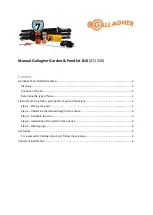
26
4. Construction and Function
MANUAL CEAG AUtoMAtiC tEst systEM At-s
+
40071860177 (C) December 2016 www.ceag.de
4 .4 .8 Bus-Technology according to RS 485 or
CG-S-Bus
An RS485 bus is used for data communication with
external bus modules (DLS/3PH oder TLS).
A connection to a BMS can be done with the CG-S bus.
The conductors of the RS485 bus line must be connected
to the connection points RS485 A, RS485 B, +24V OUT
and -24V OUT of the AT-S
+
connection terminals.
ATTENTION!
Bus Topology: linear, double terminated (no spur
lines allowed) . The absolutely essential terminating
resistors are included in the control cabinet .
•
Cable type (minimum requirement):
IY(ST)Y 4 x 2 x 0 .8 mm (Twistet Pair, screened) –
the screen of the cables must be connected to the
SE-clamps of each module and it is allowed to be
earthed in the control cabinet AT-S
+
.
•
The conductor cross-section needed for the 24V
bus voltage will depend on the line length and the
number of bus modules (U
min
= 19 V DC, refer to
the operationg instructions for the DLS/3Ph-Bus-
Module and TLS-Bus-Module)
•
Only one pair of conductors is allowed to be used
as data line within the screen – it is not acceptable
to bundle several data cables within one screened
cable!
•
The RS485 bus is not designed as a SELV system .
The bus components must be handled as if mains
supply (240V) is applied .
NOTE
•
A parallel switching of data cables is not allowed and
does not lead to an extension of the acceptable cable
length.
•
For power supply of the modules conductors within one
screening can be switched in parallel (for calculation
compare the catalogue of the system AT-S
+
).
CG-S-Bus
















































